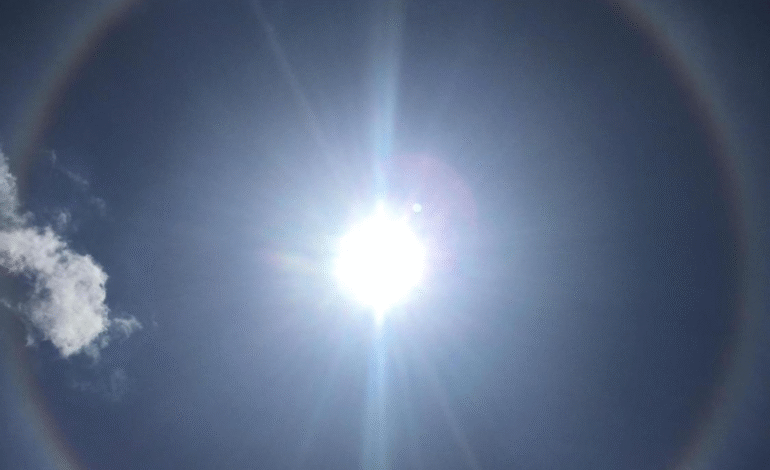Rare 22-Degree Halo Appears Around the Sun in Sharjah

On Saturday afternoon, the skies of Sharjah displayed a rare and awe-inspiring natural phenomenon, drawing the attention of residents and experts alike. The phenomenon, known as the 22° Halo, appeared as a circular ring of light surrounding the sun, captivating onlookers who witnessed its unusual beauty. Ibrahim Al Jarwan, Chairman of the Emirates Astronomical Society and a member of the Arab Union for Astronomy and Space Sciences, confirmed the occurrence and explained the underlying science behind the halo, offering insights into the atmospheric conditions responsible for such a spectacle.
The appearance of a halo around the sun is an event that often elicits wonder, with many people associating it with changes in weather. In the UAE, where clear skies are typically the norm, sightings of this optical phenomenon are rare, making it all the more fascinating when it does occur. The 22° Halo is not only a visual marvel but also serves as a signal of potential shifts in weather patterns. Understanding the science behind it provides insight into the delicate interactions of light, ice crystals, and cloud formations.
The Nature of the 22° Halo
A 22° Halo is an optical phenomenon that creates a distinct ring of light around the sun. It is caused by the refraction of sunlight as it passes through ice crystals found in high-altitude clouds, primarily cirrus clouds. These clouds, which form at elevations between 5 to 13 kilometers above the Earth’s surface, consist of tiny hexagonal ice crystals. When sunlight interacts with these ice crystals, it is bent or refracted at a specific angle—approximately 22 degrees—resulting in the formation of a circular halo around the sun.
The formation of the halo depends on the shape and orientation of the ice crystals within the clouds. Cirrus clouds are known to contain ice crystals that are perfectly suited for creating halos due to their hexagonal shape. As sunlight enters these crystals, it bends at a precise angle, resulting in the creation of a circular band of light surrounding the sun. This ring of light is most commonly visible when the sun is positioned high in the sky, but it can also be observed around the moon at night under similar conditions.
While halos can appear in different forms and sizes, the 22° Halo is specifically defined by the angle of refraction. The 22-degree angle is significant because it is the most commonly observed refractive angle that produces a bright and well-defined halo. However, the phenomenon’s appearance can vary based on environmental factors such as the size of the ice crystals and the concentration of cirrus clouds in the atmosphere.
Understanding the Physics of the 22° Halo
To fully grasp the mechanics of the 22° Halo, it’s crucial to understand the role of the ice crystals in cirrus clouds and how they interact with sunlight. Cirrus clouds are composed of microscopic ice crystals that form at high altitudes, where temperatures are cold enough for water vapor to freeze into ice. These crystals are often shaped like hexagonal prisms, and their structure is key to the formation of halos.
When sunlight passes through these ice crystals, it is refracted, or bent, as it enters and exits the crystal. The amount of bending is determined by the angle at which the light strikes the crystal’s surface and the properties of the crystal itself. Because the ice crystals in cirrus clouds are hexagonal, they cause the light to refract at a specific angle. In the case of the 22° Halo, sunlight is bent at 22 degrees as it passes through the ice crystals.
The result is a ring of light, appearing as a halo around the sun, visible to observers on the ground. The brightness and clarity of the halo depend on the number and size of the ice crystals in the clouds, as well as the angle of the sun in the sky. The halo may appear as a faint, white ring or may show a faint spectrum of colors, with red hues on the inside and violet tones on the outside, similar to a rainbow.
The 22° Halo and Its Weather Implications
The appearance of the 22° Halo is not only a visual spectacle but also carries potential implications for upcoming weather. According to Ibrahim Al Jarwan, this optical phenomenon often signals the approach of a low-pressure system or changes in the atmospheric conditions that may result in rainfall within the next 24 to 48 hours. The presence of cirrus clouds, which are associated with such halos, often indicates the presence of a weather system moving into the region.
Cirrus clouds themselves are not directly responsible for precipitation, but they can serve as an early indicator of impending weather changes. As these clouds form ahead of a low-pressure system, their appearance may be a sign that more significant cloud formations are on the way. If the 22° Halo is followed by denser clouds, it is likely that the region will experience rain or other weather changes in the near future.
In regions like the UAE, where dry and sunny conditions are the norm, the 22° Halo provides a valuable clue that rain may be on the way. For residents in Sharjah and other parts of the country, the appearance of this phenomenon may prompt them to prepare for shifting weather conditions. While the halo itself is an intriguing sight, it is also a reminder of the dynamic and constantly changing nature of the atmosphere.
The Halo Seen Across the UAE
The 22° Halo was not limited to Sharjah but was also observed in several other parts of the UAE, as high-altitude cirrus clouds covered much of the sky on that particular Saturday. The widespread visibility of the halo was a result of the extensive coverage of these clouds, which created the perfect conditions for the phenomenon to occur.
Al Jarwan noted that the halo was visible across multiple regions of the UAE, thanks to the widespread presence of cirrus clouds. These clouds are known to be the primary source of the 22° Halo, and their widespread coverage allowed for many residents to witness the rare event. In addition to its beauty, the sight of the halo sparked a sense of wonder among the public, with many people sharing images and discussing the occurrence on social media.
For the people of Sharjah, the appearance of the 22° Halo was a rare and memorable event. The region, known for its sunny and dry climate, rarely experiences such optical phenomena, making this occurrence all the more special. As people gathered to observe the halo, the event also served as an opportunity to learn more about the science behind the phenomenon and the weather patterns that accompany it.
The Aesthetic and Scientific Value of the Halo
While the 22° Halo is certainly a beautiful sight, it also offers valuable insights into the science of atmospheric phenomena. The halo is a vivid example of how light, temperature, and atmospheric conditions can work together to produce complex optical effects. For astronomers and meteorologists, the halo is a useful tool for understanding cloud formations, the movement of weather systems, and the behavior of light in the atmosphere.
The halo serves as a reminder of the intricate balance of natural forces that govern the Earth’s weather and climate. It is an impressive demonstration of how sunlight can interact with ice crystals in the atmosphere to create beautiful, ephemeral displays in the sky. Such phenomena also highlight the beauty of our planet’s atmosphere and its ability to surprise us with stunning and rare events.







